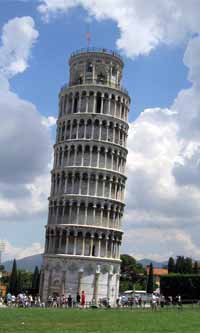Positioned behind the Cathedral, the Leaning Tower
of Pisa, often called Tower of Pisa is the beautiful
campanile, or freestanding bell tower, of the cathedral
of the Italian as well as the capital city of the Province
of Pisa, Pisa. Followed by Cathedral and the Baptistry,
this enchanting tower is the third oldest construction
in Pisa's Cathedral Squarem. An interesting tourist activity
performed by almost everyone is to pose for photographs
pretending to hold the Leaning Tower of Pisa and saving
it from coming down.
of the cathedral
of the Italian as well as the capital city of the Province
of Pisa, Pisa. Followed by Cathedral and the Baptistry,
this enchanting tower is the third oldest construction
in Pisa's Cathedral Squarem. An interesting tourist activity
performed by almost everyone is to pose for photographs
pretending to hold the Leaning Tower of Pisa and saving
it from coming down.
The fascinating tower stands with the height of 55.86
m, which is approximately 183.27 ft, from the ground
level on the stumpy side. On the other hand, the higher
side of tower is measured 56.70 m (186.02 ft). The width
of the base of the Leaning Tower of Pisa is calculated
4.09 m (13.42 ft), where as the peak is measured 2.48
m (8.14 ft). The weight of this wonder is anticipated
to be 14,500 metric tons, which is about 16,000 short
tons. The tower comprises 296 or 294 steps; also, one
gets to see two fewer steps on the seventh floor of the
north-facing staircase.
Previous to reconstruction work, executed between 1990
and 2001, the Tower of Pisa is inclined at 5.5 degree
angle, but it is currently measured to be inclined at
the angle of 3.99 degrees. It means that the summit of
the Leaning Tower has moved 3.9 meters, horizontally
from where it would be if the construction were absolutely
vertical. The construction of the Leaning Tower happened
in three different stages throughout 177 years. The construction
on the ground floor of the white marble belfry started
on 8th August 1173, during a phase of military success
and affluence. This ground floor is a blind arcade, a
famous style that composes a series of arches, formulated
by engaged columns with classical Corinthian capitals.
The tower started to lean after construction had moved
to the second floor of the structure in the year 1178.
The reason behind it is the merger of three-meter foundation,
placed in weak, unbalanced subsoil, a design that was
faulty from the initial stage. Later, the construction
was stopped due to the Republic of Pisa, which held constantly
for almost a century. In the year 1272, the construction
started again under the supervision of Giovanni di Simone,
an accomplished architect of the Camposanto. The construction
was the held to correct the tilt, which actually curved
the tower.
The construction was again stopped in 1284; at last,
seventh floor of the Leaning Tower was built in 1319.
Currently, the leaning design of the structure has become
the highlight of Pisa. The belfry is explored by millions
of visitors, every year.
LEANING TOWER OF PISA, (ITALY) |
||||||||||||||||
|
||||||||||||||||





